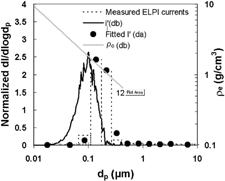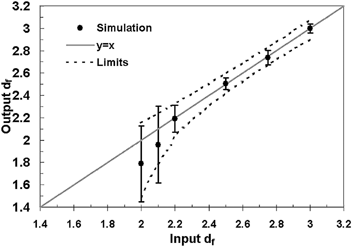Abstract
A method to find particle effective density and the fractal dimension, based on simultaneous size distribution measurements with SMPS and ELPI, is introduced. A fitting procedure is used to find the particle density as a function of particle size and the fractal dimension. The method was tested by simulation and by experimental measurements of particles with varying morphology. For fractal dimension values between 2.2 and 3.0, fractal dimension was measured with an accuracy of 0.1, and effective density was measured with 15% relative accuracy.
INTRODUCTION
In addition to composition and size distribution, an important property of aerosol particles is their morphology. Specifically, agglomerated particles are found in many fields. Combustion sources such as power plants and vehicle engines emit agglomerated particles (e.g., CitationBurtscher 1992). Particle morphology affects the behavior of the emitted particles in the atmosphere (e.g., CitationColbeck et al. 1989) and possibly their effects on health as well (e.g., Bérubé et al. 1998). Finally, for many aerosol synthesis applications, the degree of agglomeration is often the most important characteristic of the particles (for aerosol synthesis, see CitationKodas and Hampden-Smith 1999). The morphology of agglomerated particles is usually characterized by fractal dimension, a quantity that can be defined for both individual agglomerates and an agglomerate population.
Fractal dimension values of individual agglomerates have been estimated from electron microscopy images (e.g., CitationForrest and Witten 1979; CitationSamson et al. 1987; CitationKaye et al. 1987; CitationRogak et al. 1993). Electron microscopy can also be used for studying the fractal dimension for the whole particle population. In this case the number of primary particles and the radius of gyration are obtained from the images. These methods are suitable only for agglomerates with fractal dimension lower than 2. For higher values, overlapping of primary particles will distort the result. In addition to expensive electron microscopy instruments, advanced image processing methods are needed. A further drawback is that only off-line measurement is possible.
Most in situ measurement concepts are based either on light scattering or on the simultaneous measurement of particle mobility and inertia. Recent studies using light scattering methods include CitationOh and Sorensen (1997) and di CitationStasio (2001). A useful review of the method is presented by CitationSorensen (2001). The method yields information over the whole range of values of fractal dimension.
CitationAllen and Raabe (1985), and more recently CitationNyeki and Colbeck (1994), used the modified Millican Cell method (MMC) to study particle structure. By the MMC technique, mass and aerodynamic diameter of individual agglomerates can be determined, but the method is slow.
Another widely used approach is to measure particle mobility and mass (or effective density). CitationSchmidt-Ott (1988a, b) derived fractal dimension of silver particles by determining the mobility equivalent diameter and a quantity proportional to particle mass. In that method the agglomerates were heated and the structure collapsed into close-packed clusters. Further heating led to the coalescence of primary particles. The mobility equivalent diameters of the initial agglomerates, the close-packed clusters, and the primary particles were determined. The fractal dimension was then derived from these diameter values. CitationWeber et al. (1996) used a method where particle mass and mobility were measured by inductively coupled plasma optical emission spectrometry (ICP-OES) combined with differential mobility analyzer (DMA).
It is also possible to use a combination of two steady-flow instruments in series, one classifying the particles according to mobility diameter and the other according to aerodynamic diameter. In these studies, the density of DMA-classified particles is measured by an impactor. CitationSchleicher et al. (1995) and CitationSkillas et al. (1998) used a single stage low-pressure impactor. CitationMcMurry et al. (2002) studied the fractal dimension of atmospheric aerosols by classifying particles with a DMA and then measuring the particle mass with an aerosol particle mass analyzer (CitationAPM; Ehara et al. 1996). CitationMaricq et al. (2000) studied the density and the fractal dimension of diesel particles by using DMA and electrical low pressure impactor (ELPI). They classified particles by DMA and then measured the aerodynamic size of the classified particles with ELPI. Although a large number of individual particles is measured rapidly, these methods are time-consuming because one particle size has to be measured at a time.
All of the methods based on mass and mobility measurements introduced above require mobility size classification. Usually particle size distribution is also under interest and separate size distribution measurement is needed. In this study, we describe an on-line method to estimate the effective density, fractal dimension, and size distribution of particles. Our method is based on parallel measurements made by SMPS and ELPI. Distributions measured with these two instruments are fitted to correspond to each other to produce a size-dependent value for the effective density. Earlier, we have presented a similar fitting procedure to obtain density of spherical particles (CitationRistimäki et al. 2002), and some results for agglomerated diesel exhaust particles (CitationVirtanen et al. 2002). We now present a detailed description of the procedure applied to fractal-like agglomerates and test measurements with silver agglomerates.
FRACTAL DIMENSION AND EFFECTIVE DENSITY
The fractal dimension of the particles can be examined by studying the structure of single particles or the scaling of the particle mass and size for the whole particle population. The first approach is based on the fundamental finding of long range density correlation in agglomerates by CitationForrest and Witten (1979). The second one is based on the subsequent discovery that the number of primary particles in an agglomerate, and therefore agglomerate mass, is proportional to its radius of gyration through a power law (CitationWitten and Sander 1981):
EquationEquation (2) indicates that the smaller the fractal dimension d f , the looser the structure. The extreme values range from one for a straight chain to three for a spherical compact package.
The quantity linking mass and mobility diameter of irregular particles is the effective density of the particle, incorporating material density, particle shape, and porosity. The mass of a particle with mobility diameter d b and effective density ρ e is
For fractal agglomerates one can then combine EquationEquations (2) and (3) to obtain a scaling law for effective density versus mobility diameter (CitationSkillas et al. 1998, 1999),
For compact particles fractal dimension is 3 and the density is constant. For agglomerated particles, EquationEquation (4) produces a decreasing effective density as a function of mobility diameter.
Finally, effective density ρ e , aerodynamic particle diameter d a , and mobility equivalent diameter d b are connected through (CitationKelly and McMurry 1992)
For low fractal dimension values, the rapidly decreasing density value causes the aerodynamic and mobility distributions to be distinctly different. Thus low fractal dimension values resulting in a very narrow aerodynamic size distribution would be a challenge cascade impactor measurement, as the size resolution of a cascade impactor is rather limited. In addition, EquationEquation (2) is valid for d f < 2 in continuum regime only (CitationSchmidt-Ott et al. 1990; CitationWiltzius 1987). In most practical applications, a substantial part of the size distribution would be in the free molecular regime or in the transient regime. We therefore limit our study to fractal dimension values above two.
DESCRIPTION OF THE METHOD
The present method is based on simultaneous size distribution measurement with SMPS and ELPI, followed by a calculation procedure to fit the two measurement results. As a result of the fitting procedure, effective density and fractal dimension values are obtained.
Instruments
Mobility distribution was measured with SMPS (CitationWang and Flagan 1990), with TSI type 3071 (long) DMA and type 3025 CPC. Aerodynamic distribution was measured with ELPI (CitationKeskinen et al. 1992; CitationMarjamäki et al. 2000).
Calculation of ELPI Impactor Currents
This part of the method is similar to what was used for the spherical particle case earlier. Therefore, only the outline is given here. A more detailed description can be found in CitationRistimäki et al. (2002).
First, a diffusion loss-corrected, SMPS-measured number size distribution, n SMPS(d b ), is multiplied with the charger efficiency function of ELPI, E ch (d b ), to produce a new quantity, the current distribution i′(d b ):
According to CitationRogak and Flagan (1992), the potential diameter, mass transfer diameter, and the mobility diameter are expected to be the same even for nonspherical particles in the continuum regime. Also, their experimental results indicate that for SMPS inversion procedure the charging equivalent diameter can be assumed to equal the mobility diameter for agglomerates. This is supported by the experimental results of CitationWen et al. (1984). As a first approximation, we assume that the ELPI charger efficiency function is also a function of mobility diameter only, for the whole measurement range. For this crude approximation we have some support in out earlier experimental findings with diesel agglomerates (CitationAhlvik et al. 1998).
Next, the function i′(d b ) is passed through ELPI impactor resolution (kernel) functions to imitate the particle collection in impactor. The kernel functions are composed of the cutoff curves of impactor stages (CitationMarjamäki et al. 2000) and small particle deposition by diffusion, image charge, and space charge effects (CitationVirtanen et al. 2001). The response function, I′ j (d a ), resulting from calculation is now a discrete function corresponding to the measured ELPI currents and obtained from a set of integral equations (CitationRistimäki et al. 2002):
Where k is the impactor kernel function dependent on d b and ρ e (d b ). Note that the effective density is now a function of mobility diameter. As described by CitationRistimäki et al. (2002), the kernel function is also dependent on concentration through a space charge term Z.
Fitting of the Density
The last step of the method is to minimize the error between simulated ELPI stage currents, I′ j , and the measured currents, I j . As shown in , there are now two parameters which are varied to find the minimum. The first one fixes the absolute value of effective density ρ i at SMPS distribution midpoint d i . The second one, effective density ρ e , sets the slope (3-d f ) of the density versus mobility line in log–log scale in . We call the combination of these values the density profile of the particles. The profile that gives the smallest difference between the two current distributions is the result of the fitting. Note that the choice of mobility diameter to fix the absolute density is arbitrary. Below the density value ρ0 at the lowest measured mobility size d 0 is also used.
FIG. 1 Parameters varied in density fitting method (see text). The slope of the curve (3-d f ) depends on the structure of particles.

To find the best fit, the error between the measured and calculated current values is characterized by a cost function described by CitationRistimäki et al. (2002). The minimum of the cost function is searched by a two-step method. First, by fixing the fractal density value, d f , to three, best-fit value is searched for the density at the mobility size distribution midpoint, ρ i (see CitationRistimäki et al. 2002). These values are then used as initial values for a two-dimensional Nelder-Mead search algorithm (CitationNelder and Mead 1965).
As an example of different steps in the fitting method, the response, i′(d b ), which resulted from multiplying the SMPS number distribution and ELPI charger efficiency curve, is compared to measured ELPI current (dashed line) in . The fitted discrete current values, I′ j , for individual impactor stages corresponding to the found density profile (gray line) are marked with black dots.
SIMULATION
The aim of the simulation section was to study the range of size distributions, densities, and fractal dimensions that can be covered with the fitting method. Another goal was to study the effect of signal noise on the performance. In the first set of simulations, different lognormal mobility size distributions were used as input distributions. shows the range of input values tested. For each parameter, the range between minimum and maximum values was divided into 100 bins of equal width. For CMD the bins were of equal logarithmic width. To limit the number of simulations, Latin Hybercube method (see e.g., Press et al. 1992) was used to choose 100 random combinations of the parameters. To test the robustness of the search method against nonideal measurement, 5% and 10% rms noise was added to “measured” individual SMPS and ELPI channel readings, respectively, and a similar set of 100 simulations was run. The values used for rms noise are gained from typical size distribution measurements.
TABLE 1 Range of parameter values used in simulation
The results of the noise-free simulations are not plotted, as the output values agreed perfectly with the input values. The fractal dimension values in the case of added noise are shown in . There is a single erroneous point at d f = 2.23, corresponding to an extreme value of 40 nm for CMD. Otherwise, the simulated results are generally within 5% of the input value for input fractal dimension values above two. However, below this value there is heavy scatter in the simulated values. Therefore, another set of simulations was performed to study the performance of the method with fixed CMD, density, and GSD values.
FIG. 3 Fitted fractal dimension values versus input values. Simulation result with noise added to individual ELPI and SMPS channel signals.
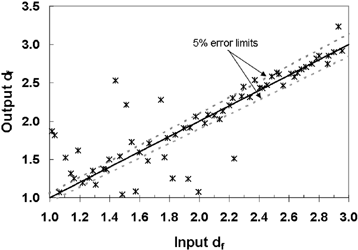
In the next phase, fixed values were chosen for CMD (100 nm), GSD (1.6), and ρ i (1.0 g/cm3). Simulation was repeated 100 times with random noise in the “measured signals.” This was performed for several fractal dimension input values ranging from 2.0 to 3.0. shows for each input fractal dimension value the average of the 100 output fractal dimension values. The error bars show the standard deviation. Down to approximately 2.2, the output value agrees well with the input value. The standard deviation values correspond to absolute error of less than 0.1. However, for input d f below 2.2, the output value underestimates the fractal dimension value. In this case, a majority of the runs ended with correct output value, but a number of runs ended showing a low fractal dimension value, close to one. This is also reflected in the increased standard deviation in the values. An estimate for error limits based on simulations is marked with the dashed lines in .
LABORATORY TESTS
To test the method with spherical, constant-density liquid particles, a number of size distributions were generated with a Collison–type nebulizer from Dioctyl sebacate (DOS), which has density 0.918 g/cm3.
Solid silver particles with different morphologies were generated by evaporating silver in a tube furnace. The evaporation temperature was 1200°C, and nitrogen was used as the carrier gas. The carrier and dilution gas flow rates were 2 and 15 lpm, respectively. The size of fresh silver particles was very small (the peak size of the SMPS number distribution was ∼ 10 nm). To obtain agglomerates with different degrees of agglomeration, two ageing concepts were used. To achieve a low degree of agglomeration, a continuous-flow ageing tube was used with a residence time of ∼ 2 min. For larger particle sizes and higher degrees of agglomeration, a 180 l batch-type ageing chamber was used. The chamber was first filled for 10 min with fresh silver particles, followed by 15 min of ageing without flow. The peak size of the distribution was increased up to ∼ 90 nm when the size distributions were measured. A dilution system was used that sampled a 1 lpm flow from the chamber. The concentration and size distribution remained practically constant during the SMPS scan.
In all cases the distributions were measured simultaneously with ELPI and SMPS. In the ELPI, a filter stage was used to extend the size range down to 10 nm. Also, the used charger parameters were appropriate for small particle measurements (CitationMarjamäki et al. 2002). In the case of solid particles, greased aluminum foils were used as impactor substrates. The flow rate for the ELPI impactor was 9.7 lpm. The SMPS aerosol and sheath flow rates were 0.6 and 6 lpm, respectively. For the fresh silver particles, higher DMA flow values of 2.0 and 20 lpm were used. During the silver agglomerate measurements, samples were also collected for electron microscopy.
To gain a reference for the density and fractal dimension values found by fitting method, measurements with DMA and impactor in series were also made simultaneously with the distribution measurements. First the particles were monodispersed in DMA. These monodispersed particles have a well-defined mobility size. The aerodynamic size of monodispersed particles was then measured with impactor. The reference measurements were made for fresh and aged silver particles. The collection efficiency curves measured for silver particles were compared with the collection efficiency curves measured with DOS particles. From the difference, the effective density of a particle having defined mobility size was found. The measurement scheme is shown in .
RESULTS AND DISCUSSION
DOS Particles
Seven distributions were measured (each once). The peak size of distributions varied from 0.03 to 0.24 μ m. The average value of fractal dimension for all measurements was 3.02 and the standard deviation was 1.9%. The found average density value for peak of the distribution is 0.98 g/cm3 (standard deviation 2%), while the density of DOS is 0.918 g/cm3.
Silver Particles
In the number distributions and density profiles found by for fresh and aged silver particles are shown. The results are average values of 5 individual measurements. The error limits given below are the standard deviations of the measurements. In the case of fresh silver particles, the found fractal dimension was 3.1 ± 0.1. The result agrees with the TEM image in (right-hand side), i.e., particles are spherical and nonagglomerated. The found value of density is 7.1 ± 0.5 g/cm3, which is clearly lower than the bulk density of silver (10.5 g/cm3). The reference method produced an average density value of 6.5 ± 0.8 g/cm3 with no dependence on particle diameter. Thus the reference results are in good agreement with results found by the fitting method. Similar low density values for spherical silver particles have been reported by several authors (e.g., CitationFernandez de la Mora and Schmidt-Ott 1993; CitationSchleicher et al. 1995; CitationHering and Stolzenburg 1995). CitationFernandez de la Mora et al. (2003) attribute the low density values to impurities in the generator or carrier gas.
FIG. 6 (a) Set of measured silver particle distributions and resulted fractal dimensions. (b) Density values for Aged II particles gained from reference method are compared to results found by fitting method in figure.
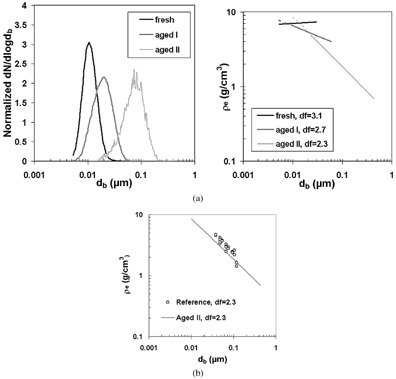
FIG. 7 Electron microscope images of fresh silver particles on the left and Aged II particles (ageing time 15 min) on the right.
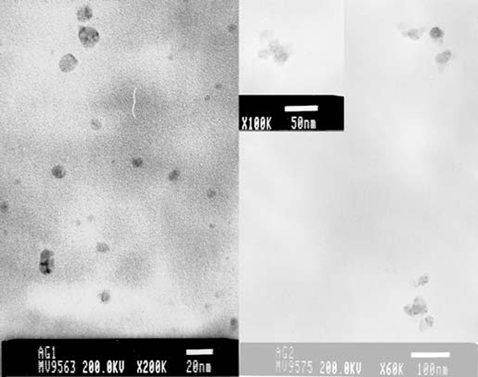
In , density profiles of the aged silver particles are also shown. The fractal dimension for silver particles aged for ∼ 2 min (aged I in ) was 2.7 ± 0.05. Most of the particles are probably formed through particle–cluster agglomeration, resulting in a high fractal dimension (CitationMeakin 1984). The found density of the smallest particles (dashed line) is larger than the density of fresh primary particles. This is probably related to a mode of primary particles still left in the aged aerosol, supported by the clear overlap of fresh silver particle distribution (median size ∼10 nm) and aged I distribution (median size ∼20 nm). This overlap also supports the assumption of particle–cluster agglomeration process. The density of this mode is in reality constant and does not increase towards smaller particle size, as assumed by the fitting procedure. Therefore, the density of smallest particles is overestimated.
For the silver particles aged for 15 min, the agreement with the reference method was good. In , the found density profile is compared with density values gained with single mobility method. Density value at the peak size of the distribution (∼0.09 μ m) found by the fitting method was 2.0 ± 0.1 g/cm3. The corresponding density value found by reference method was 2.4 g/cm3. As expected, the fractal dimension was small, 2.3 ± 0.1. The fractal dimension found by single mobility method was 2.33. These values can be compared with values gained with computer simulations of the agglomeration process presented by CitationMeakin (1984). For particle–cluster agglomeration, the calculated values for fractal dimension in continuum and free molecular regimes are ∼2.5 and ∼3, respectively. For cluster–cluster agglomeration, the simulated values in both free molecular and continuum regimes are ∼1.8–2.0. The measured fractal dimension 2.3 is between these characteristic values. It is conceivable that both types of agglomeration take place during the aging time. The agglomerates would then be formed partly through particle–cluster process and partly through cluster–cluster process, resulting in the observed fractal dimension. Particles with different morphologies were also found in the electron microscope images. Compare the particle in the upper left corner of with the other particles in the figure.
It should be noted here that the method is restricted for fractal dimension values > 2 in free-molecular and transition regimes. This limit is caused by the nature of Stokes drag on fractal aggregates (CitationRogak and Flagan 1990; CitationCai and Sorensen 1994; CitationSchimdt-Ott et al. 1990) and its effect on the relationship between R g and d b . The equality of R g and d b used in this study in limited values of d f is the basic and widely accepted assumption in agglomerate study (CitationSchmidt-Ott 1988a, b; CitationSchleicher et al. 1995; CitationSkillas et al. 1998, 1999; CitationBurtscher et al. 1998; CitationWeber et al. 1996; CitationMcMurry et al. 2002; CitationPark et al. 2003). However, it would be very interesting to compare results with those of other methods—for example, light-scattering methods—not based on mobility size measurement. This could be a topic of further studies.
The present method assumes that particle density depends on particle size, according to EquationEquation (4). If all particles in the measured distribution are agglomerates formed with the same mechanism, the found fractal dimension is valid over the whole distribution. However, if part of the particles is formed through monomer–cluster agglomeration and the other part through cluster–cluster agglomeration, the found fractal dimension is a weighed average of the two values corresponding to the two different processes. In addition, if there are primary particles left, the found fractal dimension value is again an average value, weighed with the relative concentrations of different morphology types.
In , the results and error limits of the measurements are collected and compared with the error limits found by simulations. As can be seen, the experimental error limits are in good agreement with the simulated limits. The summary of the results is shown in . The presented reference density value for DOS is manufacturer's bulk value. For silver particles, the density values shown in the table are densities of peak size of the distributions. Reference values for silver particles are the values gained from reference method.
FIG. 8 Measured fractal dimension values and error limits compared with error limits found in simulations. Note that no reference value for Silver Aged I is available; place in x axis is the average of measured values.
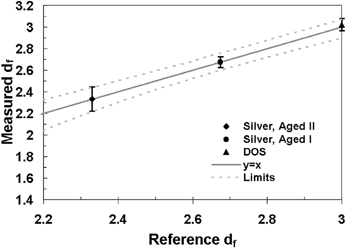
TABLE 2 Summary of the results
CONCLUSIONS
The method introduced here is a fast way to find out information about particle density and fractal dimension. The method is valid only for fractal dimension values > 2. The method is experimentally very easy to apply; it is practically a byproduct of size distribution measurement. No additional measurements besides ELPI and SMPS size distribution measurements are needed. The standard deviation of both simulations and laboratory measurements was less than 0.1 for fractal dimension values from 2.2. to 3. A corresponding error estimate for density values is 15%. The simulation results indicated that the error estimates increase rapidly for fractal dimensions lower than 2.2. This is caused by local minima in the cost function at very low fractal dimension values. It might be possible to reach lower fractal dimension values by a more intelligent search routine, but this was not studied.
If the measurements are done carefully and if the cut curves of the impactor are well known the found results are good, as was shown in this study. It should be noticed that obviously the method is sensitive to the nonideality of the measurement. For example, particle bounce in the impactor or an error in the instrument flow rates may cause error in the found density profile. The particle source should be stable enough to prevent distortion of the SMPS-measured size distribution. Of course, the number distribution should be within the measurement range of SMPS.
REFERENCES
- Ahlvik , P. J. E. , Ntziachristos , L. , Keskinen , J. and Virtanen , A. 1998 . Real Time Measurements of Diesel Particulate Size Distribution with an Electrical Low Pressure Impactor . SAE 1998 Transactions—Journal of Fuels and Lubricants , SAE paper 98041
- Allen , M. D. and Raabe , O. G. 1985 . Slip correction measurements for aerosol particles of doublet and triangular triplet aggregates of spheres . J. Aerosol Sci. , 16 : 57 – 67 .
- Bérubé , K. A. , Jones , T. P. , Willimason , B. J. , Winters , C. , Morgan , A. J. and Richards , R. J. 1999 . Physicochemical Characterisation of Diesel Exhaust Particles: Factors for Assessing Biological Activity . Atmos. Environ. , 33 : 1599 – 1614 .
- Burtscher , H. 1992 . Measurement and Characteristics of Combustion Aerosol with Special Consideration of Photoelectric Charging and Charging by flame ions . J. Aerosol Sci. , 23 : 549 – 595 .
- Burtscher , H. , Künzel , S. and Hüglin , C. 1998 . Characterization of Particles in Combustion Engine Exhaust . J. Aerosol Sci. , 29 : 389 – 396 .
- Cai , J. and Sorensen , C. M. 1994 . Diffusion of Fractal Aggregates in the Free Molecular Regime . Phys. Rev. E. , 50 : 3397 – 3400 .
- Colbeck , I. , Hardman , E. J. and Harrison , R. M. 1989 . Optical and Dynamical Properties of Fractal Clusters of Carbonaceous Smoke . J. Aerosol Sci. , 20 : 765 – 774 .
- di Stasio , S. 2001 . Observation of Restructuring of Nanoparticle Soot Aggregates in a Diffusion Flame by Static Light Scattering . J. Aerosol Sci. , 32 : 509 – 524 .
- Ehara , K. , Hagwood , C. and Coakley , K. J. 1996 . Novel Method to Classify Aerosol Particles According to Their Mass-to-Charge Ratio—Aerosol Particle Mass Analyser . J. Aerosol Sci. , 27 : 217 – 234 .
- Fernández de la Mora , J. , de Juan , L. , Liedtke , K. and Schmidt-Ott , A. 2003 . Mass and Size of Nanometer Particles by Means of Mobility Analysis and Focuded Impaction . J. Aerosol Sci. , 34 : 79 – 98 .
- Fernandez de la Mora , J. and Schmidt-Ott , A. 1993 . Performance of Hypersonic Impactor with Silver Particles in the 2 nm Range . J. Aerosol Sci , 24 : 409 – 415 .
- Forrest , S. R. and Witten , T. A. 1979 . Long-Range Correlations in Smoke-Particle Aggregates . J. Phys. A: Math. Gen. , 12 : 109 – 117 .
- Hering , S. V. and Stolzenburg , M. R. 1995 . On-line Determination of Particle Size and Density in the Nanometer Size Range . Aerosol Sci. Tech , 23 : 155 – 173 .
- Kaye , B. H. , Clark , G. C. , Leblanc , J. E. and Trottier , R. A. 1987 . Image Analysis Procedures for Characterizing the Fractal Dimension of Fineparticles . Part. Charact. , 4 : 63 – 66 .
- Kelly , W. P. and McMurry , P. H. 1992 . Measurement of Particle Density by Inertial Classification of Differential Mobility Analyzer-Generated Monodisperse Aerosol . Aerosol Sci. Tech. , 17 : 199 – 212 .
- Keskinen , J. , Pietarinen , K. and Lehtimäki , M. 1992 . Electrical Low Pressure Impactor . J. Aerosol Sci. , 23 : 353 – 360 .
- Kodas , T. T. and Hampden-Smith , M. J. 1999 . Aerosol Processing of Materials , Wiley-VCH .
- Maricq , M. M. , Podsialik , D. H. and Chase , R. E. 2000 . Size Distribution of Motor Vehicle Exhaust PM: A comparison Between ELPI and SMPS Measurement . Aerosol Sci. Technol. , 33 : 239 – 260 .
- Marjamäki , M. , Keskinen , J. , Chen , D.-R. and Pui , D. Y. H. 2000 . Performance Evaluation of the Electrical Low-Pressure Impactor (ELPI) . J. Aerosol Sci. , 31 : 249 – 261 .
- Marjamäki , M. , Ntziachristos , L. , Virtanen , A. , Ristimäki , J. , Keskinen , J. , Moisio , M. , Palonen , M. and Lappi , M. 2002 . Electrical Filter Stage for ELPI , SAE Paper No. 2002–01-0055
- McMurry , P. H. , Wang , X. , Park , K. and Ehara , K. 2002 . The Relationship Between Mass and Mobility for Atmospheric Particles: A new Technique for Measuring Particle Density . Aerosol Sci. Technol. , 36 : 227 – 238 .
- Meakin , P. 1984 . Computer Simulation of Cluster-Cluster Aggregation Using Linear Trajectories: Results from Three-Dimensional Simulations and a Comparison with Aggregates Formed Using Brownian Trajectories . J. Colloid Interf. Sci. , 102 : 505 – 512 .
- Nelder , J. A. and Mead , R. 1965 . A Simplex Method for Function Minimization . Computer J. , 7 : 308 – 313 .
- Nyeki , S. and Colbeck , I. 1994 . The Measurement of the Fractal Dimension of Individual in Situ Soot Agglomerates Using a Modified Millikan Cell Technique . J. Aerosol Sci. , 25 : 79 – 90 .
- Oh , C. and Sorensen , C. M. 1997 . Light Scattering Study of Fractal Cluster Aggregation Near the Free Molecular Regime . J. Aerosol Sci. , 28 : 937 – 957 .
- Park , K. , Cao , F. , Kittelson , D. and McMurry , P. 2003 . Relationship Between Particle Mass and Mobility for Diesel Exhaust Particles . Environ. Sci. Technol. , 37 : 577 – 583 .
- Ristimäki , J. , Virtanen , A. , Marjamäki , M. , Rostedt , A. and Keskinen , J. 2002 . On-line Measurement of Size Distribution and Effective Density of Submicron Aerosol Particles . J. Aerosol Sci. , 33 : 1541 – 1557 .
- Rogak , S. N. and Flagan , R. C. 1990 . Stokes Drag on Self-Similar Clusters of Spheres . J. Colloid Interface Sci. , 134 : 206 – 218 .
- Rogak , S. N. and Flagan , R. C. 1992 . Bipolar Diffusion Charging of Spheres and Agglomerate Aerosol Particles . J. Aerosol Sci. , 23 : 693 – 710 .
- Rogak , S. N. , Flagan , R. C. and Nguyen , H. V. 1993 . The mobility and Structure of Aerosol Agglomerates . Aerosol Sci. Technol. , 18 : 25 – 47 .
- Samson , R. J. , Mulholland , G. W. and Gentry , J. W. 1987 . Structural Analysis of Soot Agglomerates . Langmuir , 3 : 272 – 281 .
- Schleicher , B. , Künzel , S. and Burtscher , H. 1995 . In Situ Measurement of Size and Density of Submicron Aerosol Particles . J. Appl. Phys. , 78 : 4416 – 4422 .
- Schmidt-Ott , A. 1988a . In Situ Measurement of the Fractal Dimensionality of Ultrafine Aerosol Particles . Appl. Phys. Lett. , 52 : 954 – 956 .
- Schmidt-Ott , A. 1988b . New Approach to In Situ Characterization of Ultrafine Agglomerates . J. Aerosol Sci. , 19 : 553 – 563 .
- Schmidt-Ott , A. , Baltensberger , U. , Gäggler , H. W. and Jost , D. T. 1990 . Scaling Behaviour of Physical Parameters Describing Agglomerates . J. Aerosol Sci. , 21 : 711 – 717 .
- Skillas , G. , Burtscher , H. , Siegmann , K. and Baltensberger , U. 1999 . Density and Fractal-like Dimension of Particles from a Laminar Diffusion Flame . J. Colloid Interface Sci. , 217 : 269 – 274 .
- Skillas , G. , Künzel , S. , Burtscher , H. , Baltensberger , U. and Siegmann , K. 1998 . High Fractal-like Dimension of Diesel Soot Agglomerates . J. Aerosol Sci. , 29 : 411 – 419 .
- Sorensen , C. M. 2001 . Light Scattering by Fractal Aggregates: A Review . Aerosol Sci. Technol. , 35 : 648 – 687 .
- Virtanen , A. , Marjamäki , M. , Ristimäki , J. and Keskinen , J. 2001 . Fine Particle Losses in Electrical Low Pressure Impactor . J. Aerosol Sci. , 32 : 389 – 401 .
- Virtanen , A. , Ristimäki , J. , Marjamäki , M. , Vaaraslahti , K. , Keskinen , J. and Lappi , M. 2002 . Effective Density of Diesel Exhaust Particles as a Function of Size , SAE Paper No. 2002–01-0056
- Wang , S. C. and Flagan , R. C. 1990 . Scanning Electrical Mobility Spectrometer . Aerosol Sci. Technol. , 13 : 230 – 240 .
- Weber , A. P. , Baltensberger , U. , Gäggler , H. W. and Schmidt-Ott , A. 1996 . In Situ Characterization and Structure Modification of Agglomerated Aerosol Particles . J. Aerosol Sci. , 27 : 915 – 929 .
- Wen , H. Y. , Reischl , G. P. and Kasper , G. 1984 . Bipolar Diffusion Charging of Fibrous Aerosols Particles—II Charge and Electrical Mobility Measurements on Linear Chain Aggregates . J. Aerosol Sci. , 15 : 103 – 122 .
- Wiltzius , P. 1987 . Hydrodynamic Behaviour of Fractal Aggregates . Phys. Rev. Lett. , 58 : 710 – 713 .
- Witten , T. A. and Sander , L. M. 1981 . Diffusion-Limited Aggregation, a Kinetic Critical Phenomena . Phys. Rev. Lett. , 47 : 1400 – 1403 .
